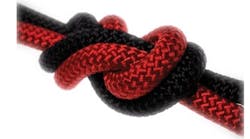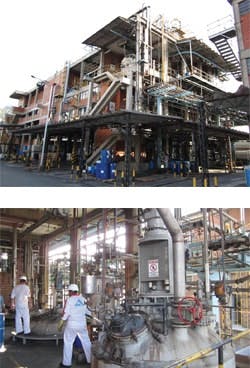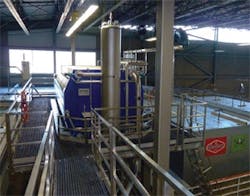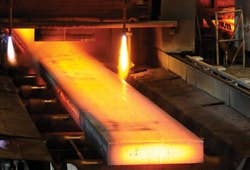Jim Montague is the executive editor for Control, Control Design and Industrial Networking. Email him at [email protected].
Just as smaller, slower streams eventually carve out larger, faster rivers, industrial networking evolved from separate methods for individual purposes to common pathways that can handle many different tasks.
Analog signals and data that used to be brought in by point-to-point wires, cables, connectors and cabinets have given way to digital fieldbuses, Ethernet, wireless and Internet-enabled networks that jointly manage data from multiple applications. Power, temperature, vibration, pressure, flow, speed and other traditional values continue to be generated at more varied sources than ever before, but they're more quickly converted into digital formats that can be sent via common networks to controllers and enterprise levels for quicker analysis and better decision making.
In short, microprocessors and software don't care what kind of ones and zeros they chew on, and this brings together process, discrete, motion, power and other functions that used to require dedicated communications and networks.
For instance, W. Müller in Troisdorf, Germany, builds extrusion heads and platforms for retrofitting onto blow molding machines, which are producing more complex and capable bottles and other products with multilayered walls. Müller's CoEx extrusion head works with six extruders to produce a three- to seven-layer, co-extruded plastic strand, which combines a glossy exterior, layer-coupling agents and inner layers that protect consumer products from oxygen or UV radiation and extend their shelf lives.
Because it requires open, flexible controls to integrate new heads onto existing and new machines, Müller switched to EtherCAT networking and TwinCAT software from Beckhoff Automation (www.beckhoff.com). These enable the control-cabinet and other IPCs with dual-core processors to control the extruders' heating zones and wall thicknesses at the same time. Over the sub-distributions of EtherCAT's terminal system, signals provided by the blow-molding machine are logged along with servo-axis motion data and heating zone process-variable information. Generally, one servo axis is used per extrusion machine, and a further axis is used for wall thickness control.
"I/O data comes from the thermocouples" explains James Birt, Müller's control technologist. "Our concept uses a large number of individual heaters, since this is the best way to control the flow of material. A maximum of 220 heating zones are available in the control system, although 50 heating zones are usually sufficient, even for larger systems. There also are numerous temperature-controlled zones for water-cooled feed zones or valve control. The openness and flexibility of this control technology and networking enables us to integrate existing machine signals and drive technology along with temperature controls from third-party suppliers without great expense, and it helps us meet customer requirements for various bus systems."
Batch Principles Aid Instruments
Similarly, Amtex decided in 2010 to automate one of the five reactors at its functional polymers plant in Medellín, Columbia, so it could operate using improved batch methods, follow ISA-S88 standards, move from traditional supervisory batch management to production-based management, and aim to achieve about a 30% production increase. The firm worked with system integrator Automatización S.A. (www.automatizacion.com.co), and together they implemented the first batch application of ABB's System 800xA distributed control system (DCS) in Columbia (Figure 1).
Figure 1: Amtex's functional polymers plant in Medellín, Columbia, upgraded its five reactors with ISA-S88-compliant batch management software aided by Profibus PA/DP converters, and increased production by 35%.
Amtex is Latin America's largest producer of sodium carboxymethylcelullose (CMC), and its four plants in Mexico, Columbia and Argentina have an installed capacity of 32,000 metric tons per year. Marketed under Amtex's Gelycel brand name, CMC is an anionic polymer derived from cellulose that's used as a thickener in the food, pharmaceuticals and oil industries. Amtex has two plants in Columbia, one annually produces 15,000 metric tons of CMC, and the other produces 14,000 metric tons per year of functional polymers.
Consequently, Amtex and Automatización outfitted the reactor with System 800xA Batch Management, which is ISA-S88-compliant, recipe-management, procedural-control software for configuring, scheduling and managing batch operations. The batch software was implemented in conjunction with the reactor's two AC800M controllers, network controls and AC800M connectivity server, which covers 600 tags. The first controller performs process control, while the second is for auxiliary equipment and includes connecting plant meters via a Modbus RTU network to prevent possible data traffic overloads on the process controllers.
In general, ISA-S88 standardizes production controls to better meet customer requirements. ISA-S88 started out in process control applications, but its commonsense, flowchart-based procedures have been so popular that the World Batch Forum (www.mesa.org) has reported its principles are applied to continuous processes and packaging applications, and it's even helped standardize working relationships between process, control and IT people because it gives them a common language. ISA-S88 also enables modular software designs, which can be more easily reused in different applications.
The polymer reactor at Amtex includes a batch server that runs 50 equipment clients and a data-management server that generates reports for raw materials, energy consumption, steam and water use, and other production and process variables, events and alarms. It also includes two production-management clients, one engineering and two operator workstations, and three controllers. The main controller also has five Profibus-DP modules—one for each reactor to connect remote I/O modules, drives and Profibus-PA instruments.
To coordinate its process and discrete functions to better meet ISA-S88 requirements, the reactor also includes a rack for the controllers and DP/PA converters, as well as four distributed control racks that have remote I/O modules connected via Profibus-DP. Each reactor also has a Profibus-DP master module to which variable-speed drives and I/O modules for rotating equipment are connected via remote DP/PA converters. The upgrade project also implemented Profibus-PA instruments such as pressure transmitters, temperature transmitters and Coriolis mass flowmeters.
After a few months, Amtex reports product quality from the newly automated reactor was so much better than the other four that it decided to upgrade them as well. With its polymer process fully automated, the plant increased production by 35%, gained more real-time production information, secured historical data to further improve decision-making and plans to implement System 800xA at its CMC plant in Columbia.
"We're convinced we can offer our customers reliability and repeatability in our products by using ISA-S88-compliant batch management and System 800xA," says Juan Camilo Arango, general manager at Amtex. "Nowadays, customers worldwide seek minimal changes in their process, and the only way of managing it is by reducing process variables."
Ethernet Assists Intelligence
Of course, one of the main factors enabling formerly separate process and discrete networks to come together is Ethernet and its common, widely accepted network cabling and hardware, which allows users to pull digital networking further down into production layers and further out into field applications.
For example, though it grew 15% per year from 2005 to 2010, Full Sail Brewing (www.fullsailbrewing.com) in Hood River, Oregon, needed to migrate away from its manual mash-filtration process, which required continuous, manual data-testing and reporting, and would restrict future production demands, efficiency and cost-cutting efforts, and quality improvements. In addition, spent grain after filtration had an 82% moisture content, which meant that valuable product was leaving as a heavier, more costly to transport byproduct.
Full Sail considered adopting a fully computerized brewing system, but it would have required 24/7 operation to achieve return on investment (ROI) and would have compromised the employees' work-life balance. The brewery also wanted to create a more scalable solution, improve filtration efficiency and minimize operator dependence on automation.
As a result, Full Sail worked with system integrator Aurora Industrial Automation in Portand, Oregon, to implement Rockwell Automation's PlantPAx process automation system with Logix Batch and Sequence Manager (LBSM), which also complies with the ISA-S88 batch standard. LBSM allows Full Sail to configure sequences directly into its ControlLogix controller through its FactoryTalk View HMI software without needing server-based batch software.
In addition, FactoryTalk Historian software identifies and gathers tags from PlantPAx to provide real-time production data from Full Sail's 60-step filtration process. So where its old manual filtration system collected only four or five data points, the new FactoryTalk-enabled filter can pull up to 250 tags (Figure 2).
Figure 2: Full Sail Brewing’s new mash filtration system pulls up to 250 tags via components on its EtherNet/IP network and increased its brewing capacity by 25%, cut raw material costs by 5% and saved 1 million gallon of water per year.
"All our PLCs are tied together using EtherNet/IP and Data Highway Plus (DH+) networks, so every PLC in the facility can communicate with any other PLC or PanelView station," explains Jamie Emmerson, Full Sail's executive brewmaster. "We use a Control Logix rack with a 1756-ENBT Ethernet bridge and 1756-DHRIO DH+ module to link the two networks. Our PLCs include three SLC 5/04s, five 5/05s, two Control Logix, seven CompactLogix, five MicroLogix and one PLC 5 that all talk to each other and the 12 PanelView Plus HMIs on the same network.
"On the device level, we use DeviceNet, EtherNet/IP and remote I/O. Most of the brewhouse, bottling line, and waste treatment are tied in. The communication networks and PanelViews allow easier interfaces for the operators. Before, they had to identify which machine, and physically go over to see what was going on. Now, alarms and warnings occur, and most can be handled remotely"
Finally, FactoryTalk VantagePoint software aggregates this data into predefined dashboards. This real-time data helps Full Sail optimize filtration as it's happening, and catch discrepancies that might occur during a batch. "We make about 20 varieties of beer," says Emmerson. "Now, brewers of each batch benefit from the information available from the previous brew. They can see the metrics that produced a successful batch and optimize the new brew based on that data."
Thanks to its new filtration system, Emmerson adds Full Sail increased its brewing capacity by 25% and cut its brew-cycle time in half. Also, because operators can optimize brews on the fly, Full Sail trimmed raw material costs by 5% per year, removed more moisture from its spent grain, and cut annual water use by 1 million gallons.
"The key to all this is how process control and factory automation have evolved over the years," says Ira Sharp, product manager for I/O and networks at Phoenix Contact. "Everyone used to distribute connectivity from their I/O points to get intelligence into the field, and this meant various protocols, controllers, racks of I/O and parallel wires from sensors all the way back to landing on separate I/O cards, and then converting to digital signals. Now, instead of converting at the rack, we put remote I/O cards on the machine or in the field, and send bus cables back to the controllers. Three years ago, we released our third-generation remote I/O strategy, which focuses entirely on Ethernet communications."
Unlike typical remote I/O devices that need an extra processor for protocol conversions, data encryption and decryption between bus couplers and controllers—and which also add latency—Sharp says that its Axioline remote I/O achieves microsecond-level conversion from I/O to protocol. "It's like a terminal block for protocols, so if you're running an EtherNet/IP network, you don't have to worry about delays in the protocol to the I/O drop," Sharp explains. "The process industries also are moving toward remote I/O strategies with their distributed I/O and electronic marshalling, which also collect instrument signals, convert them for transmission via Ethernet, and give them to the controllers. About 90% of process field devices still are considered stranded, but this situation is getting better."
New Controls Coordinate Protocols
While Ethernet provides common cabling for process, discrete and other applications, there's no guarantee that participants on it will be able to communicate or interoperate with each other. In fact, most don't interact directly, even though they're on the same data highway. This is one of Ethernet's persistent drawbacks, even though suppliers keep on parroting about how "open" it is. Fortunately, better data-translating software and microprocessors, more widely standardized Ethernet flavors and more capable control systems are picking up some of this slack.
For instance, Merck Serono Biotech Center (MSBC) in Corsier-sur-Vevey, Switzerland, produces biopharmaceuticals from large molecular structures, such as proteins created from living cells using recombinant DNA technology. MSBC presently makes the active ingredient in Merck Serono's Rebif multiple sclerosis medicine and Erbitux targeted cancer therapy. To expand production of monoclonal antibodies such as Erbitux, MSBC completed a new, large-scale biotech (LSB) facility in 2012, including an upstream plant, downstream plant, utility area for supplying clean water, air and steam, and an onsite wastewater treatment plant.
Of course, all of the LSB's new applications are monitored and managed by more than 2,000 Foundation fieldbus (FF) devices and nearly 6,500 Profibus control valves. So MSBC sought help from Yokogawa Deutschland (www.yokogawa.com), which installed them along with its Centum VP production control system. This core automation software takes in and integrates data from PLCs and other components with Profibus, FF and other interfaces, and then distributes it to VP Batch software to help manage recipes and parameters and Exaquantum/Batch plant information management system to generate batch reports required by 21 CFR Part 11 regulations. In addition, Yokogawa's PRM plant resource management software was used at plant start-up to check loops, parameters and different control valve types, and diagnose them. This enables it to perform proactive maintenance, and schedule Profibus and FF-based field device checks. Also, because all devices can be monitored online with PRM, the plant can operate with fewer field staff.
"Our target for the Vevey facility is for it to be an integrated e-plant from vial to bulk," says Nicholas Martin Clement, Merck Serono's ePlant manager. "We're continuing to automate plant operations, and make this a highly efficient operation with less impact on the environment. In this integrated e-plant, engineers and operators have access at any location to what's going on with the plant's processes, so they can make quicker and more timely decisions."
Naturally, cases of new control systems and software handling multiple communication protocols are even more remarkable in light of their networks' divergent backgrounds. Randy Durick, network and interface division director at Turck (www.turck-usa.com), explains the main difference between discrete and process networks is that discrete networks are historically byte-level and require speed to serve the automotive and manufacturing applications where they originated, while process networks value data quality and sophistication over speed because of the pressure, temperature and level values in their traditional oil, gas and other process applications.
"A handful of Ethernet versions, including EtherNet/IP, Profinet, Modbus TCP, EtherCAT and Ethernet Powerlink, are gaining popularity because users can move a lot more data faster; their underlying Ethernet infrastructure, hardware, connectors and topology are well-known; and they can handle innovative solutions in the field," Durick says. "And because protocols like Profinet and regular TCP/IP can be on the same wire, developers even find ways for two networks to exchange data by using devices like our Ethernet Spanner, which employs embedded switches and IP addresses to bridge each network."
Driven to the Device-Level
Ironically, as intelligence and Ethernet make their way into the field, many components out there rely on some new and rediscovered networking methods. Two notable examples are 25-year-old, device-level protocol AS-i and point-to-point newcomer IO-Link. Both are useful to deliver basic process and discrete signals from instruments up to higher-level networks.
"AS-i originally was developed for the machine side, but it's now heavily used on the process side," says Helge Hornis, manager of the Intelligent Systems Group at Pepperl+Fuchs. "Valve manufacturers in North America found that AS-i was easy to use, fast, inexpensive and could go into Class I, Div 2 areas. This is really where the process and discrete networking worlds meet."
Turck's Durick adds, "Previously, Ethernet was deployed at the controller level and above, but now it's getting to the device level to support process measurement devices that check temperature, level and flow, as well as positioning devices, linear transducers and encoders. Turck's innovation is our MP1 multi-protocol technology, which has a microprocessor with three protocols and can self-configure to whichever protocol is being used on its network. This means users can put an I/O device and an Ethernet gateway in a box, and they no longer need a converter between them to talk Profinet, EtherNet/IP or Modbus TCP."
Multipurpose Backbone
Once process and discrete applications and their networks come together, it can seem like everyone else wants to jump on the bandwagon. Wireless accessories, video feeds, and even safety capabilities and other crucial functions are getting in on the act—fueling the need for even better coordination by all network controls.
For example, Gerdau Ameristeel in Tampa, Florida, operates 11 mini-mills in the U.S., including its mill in Jacksonville, Florida, which has a melt shop with about 10,000 I/O points and a rolling mill with about 13,000 I/O points both which combine process variables and discrete signals (Figure 3). Nationally, Gerdau's operations are controlled by 19 different types of PLCs, which are organized by KepServerEx software from Kepware Technologies, and the PLCs report to a QMOS manufacturing execution system (MES). The melt shop and rolling mill also employ InTouch software and terminal services from Wonderware to support thin clients and use Kepware's LinkMaster software to access data from multiple OPC data sources via Ethernet, and integrate network protocols from multiple suppliers into one software-based solution.
Figure 3: When PLC scan rates slowed and stopped at Gerdau Ameristeel's melt shop and rolling mill in Jacksonville, Florida, it used KepServerEx software's ability to read many types of PLCs to centralize formerly separate communications on one server.
More recently, the plant integrated a standalone IBA historian, which pulls client data from its Kepware devices. Presently, the Jacksonville plant logs all its tags, which allows engineers and operators to track problems down to the smallest details and recreate any operator actions done using Wonderware or push buttons. "QMOS figures out what ingredients are needed for ordered products, and recipes for those orders reside in QMOS and Wonderware," says Jarrod Parrotta, improvement facilitator at Gerdau's Jacksonville plant. "QMOS tracks each step in the process and all critical operational parameters, such as amps, pressures, kilowatt hours, time start/stop. Moving products from one station to the next triggers and racks PLC events, and they're all communicated via KepServerEx and LinkMaster. Also, with the current system configuration, I don't have to let anyone through the firewall because using the two Kepware servers across the firewall allows me to provide a security control feature and limit the amount of traffic on the process network."
However, when the mill recently sought to add more Wonderware terminals and I/O points, its PLC scan rates slowed down, stopped communicating and skipped a whole scan cycle, according to Parrotta. Fortunately, his team used KepServerEx to centralize separate communications on one server. "Rather than having five or six clients pulling data from PLCs, which was mostly repetitious, we had one Kepware server that clients pulled from," explains Parrotta. "Our two challenges were the overtaxed PLCs and managing network traffic from the process and corporate domains, and KepServerEx's ability to read many PLCs helped us overcome them."
Beyond coordinating orders and existing operations, Phoenix Contact's Sharp adds, "We can even do safety control via remote I/O without a safety PLC by using our Safety Bridge, which takes safety processes and puts them on a standard network, and collects regular I/O signals and safety control on the same I/O block."
Of course, this is where security becomes even more paramount. Ethernet is easy, redundant and expandable, but its very accessibility can be a big negative if it lacks security. "So our MGuard security and firewall appliances allow users to define who and what communications are allowed in and out of their networks," Sharp says. "Industrial applications also require DIN-rail mounting, 24-Vdc cabinets and hazardous-area approvals where needed. Discrete factory-floor networks already have a lot of Ethernet, so they need more security, but process networks are adding more Ethernet to replace parallel networks, so they need more security, too. This is all in the name of giving users the data they need to know what's going in with their remote assets for better service and operations, but then decreasing network complexity at the same time."








